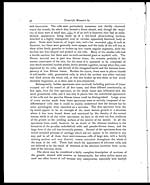Medicine - Institutions > Army health reports and medical documents > Scientific memoirs by medical officers of the Army of India > Part V, 1890 > 2 - On the pathological histology of Rhinoscleroma
(51) [Page 41]
Download files
Individual page:
Thumbnail gallery: Grid view | List view
![(1) [Page 41] -](https://deriv.nls.uk/dcn17/7500/75000403.17.jpg)
On the pathological histology of Rhinoscleroma.
BY
SURGEON-MAJOR G. BOMFORD, M.D.,
BENGAL MEDICAL SERVICE.
An opportunity has occurred during the past year of examining microscopically
the affected tissues in five cases of this rare disease. One of them was
under the care of Surgeon-Major Raye at the Medical College, Calcutta, and the
other four were treated at Indore, Central India, by Surgeon-Major Keegan, the
Residency Surgeon. The latter officer has published an account of his cases in
the Indian Medical Gazette for January 1889, and it is sufficient therefore for
the present purpose to state that the diagnosis appears to be unquestionable, as
the characteristic clinical phenomena were well marked in all the cases.
Mr. Jonathan Hutchinson, on receipt of some sketches of the cases sent to him
by Dr. Keegan, writes, "I shall put the sketches in the Museum of the College
of Surgeons. They appear to me to be good examples of the disease."
The first specimen received for examination was a portion from the upper
lip of Dr. Keegan's first case, preserved in alcohol. That some change had
occurred in the tissue was at once evident, for it had a waxy consistence
and was wanting in the leathery toughness and tendency to creak under the
knife that characterises healthy skin when so preserved. Over the greater part of
the surface the epithelium was not obviously changed in its details, but appeared
as a whole to be thinned and flattened out, with few and shallow interpapillary
processes and scanty interstitial cement substance. There were occasionally, how-
ever, distinct projections of the epithelium downwards into the true skin, but this
condition was not nearly so frequent nor so pronounced as it often is in Delhi Boil,
Elephantiasis, Syphilitic and other inflammatory growths in the skin. In some
places also the epithelium had been entirely destroyed by ulceration. There was
nothing to be seen at all resembling epithelial nests. The essential change had
evidently occurred in the true skin, which was profusely infiltrated with cells of
rather a peculiar character and converted into a dense, finely granular, but semi-
transparent kind of fibrous tissue. The whole had rather the appearance of
fibro-elastic cartilage, and was traversed by dilated vessels, of which the walls
were in many cases thickened and hyaline, while the lumen was often packed
G
Set display mode to: Large image | Zoom image | Transcription
Images and transcriptions on this page, including medium image downloads, may be used under the Creative Commons Attribution 4.0 International Licence unless otherwise stated. ![]()
| Permanent URL | https://digital.nls.uk/75000401 |
|---|
| Shelfmark | IP/QB.10 |
|---|---|
| Additional NLS resources: | |




